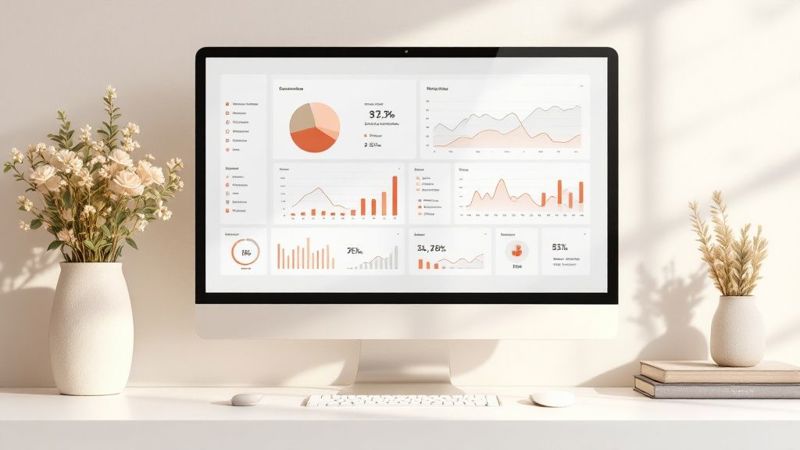Navigating Today's Shifting Social Media Landscape

The social media world is constantly changing. Brands need to adapt their strategies to stay relevant and keep their audience engaged. What worked yesterday might not work today. Understanding the current social media landscape and user behaviors is crucial for improving engagement.
This means analyzing how audience attention shifts, how people consume content, and what trends are emerging on different platforms. It's not just about getting likes, it's about understanding what motivates people to interact genuinely with your brand.
As of early 2025, a whopping 63.9% of the global population uses social media, spending an average of 2 hours and 21 minutes per day. This shows the massive potential of reaching a huge audience through these platforms. Discover more insights about social media usage. However, it also means there's more competition than ever for user attention.
Understanding Audience Fragmentation
Audience attention is becoming increasingly fragmented. Users are spread across various platforms like Facebook, Instagram, Twitter, and LinkedIn, each with its own distinct culture and content style.
This requires a more thoughtful approach to content creation. Messages need to be tailored to resonate with the specific audience of each platform. A visual post that does well on Instagram might not perform the same way on a text-based platform like Twitter. Understanding these platform nuances is key to maximizing engagement.
Leveraging Platform-Specific Features
Social media platforms are constantly evolving, introducing new features and algorithms. These changes directly impact the visibility of your content. For example, Instagram's focus on Reels and Stories requires brands to create short, engaging videos.
LinkedIn's algorithm, on the other hand, favors longer, thought-provoking content that encourages professional discussion. Simply reposting the same content across all platforms is no longer a good strategy.
Emerging Formats and Trends
Short-form video content and interactive features like polls and quizzes offer new ways to boost engagement. These formats create more dynamic and immersive experiences for users. Instead of passively consuming content, users are encouraged to actively participate.
This active participation is a strong signal of genuine engagement. It can lead to increased brand loyalty and advocacy. Staying informed about these new trends and experimenting with different formats is essential for keeping your social media strategy current and effective.
Crafting Content That Sparks Real Conversations

Creating engaging social media content isn't just about posting regular updates. It's about fostering genuine interactions and building a community around your brand. This means understanding your audience and creating content that truly connects with their interests and needs, encouraging active participation instead of passive scrolling.
Understanding the Psychology of Engagement
Improving social media engagement hinges on understanding what motivates people to interact. Consider your audience as individuals with their own unique interests. What kind of content would stop them mid-scroll?
Asking thought-provoking questions, for example, can spark comments and discussions. Tapping into current events or cultural moments makes your content relevant and timely, boosting the chances of shares and creating a shared experience.
Furthermore, offering valuable content positions your brand as a trusted resource. Think helpful tips, informative articles, or entertaining videos. When your audience finds value in your content, they're more likely to engage and share it with their network. You might be interested in: How to master marketing personalization.
Content Formats That Drive Interaction
Different content formats achieve different levels of engagement. Simple text posts can be informative, but richer media often performs better.
- Videos: Short, engaging videos, especially those that tell stories or offer valuable information, tend to be very effective.
- Images: High-quality visuals are key for grabbing attention. Infographics and carousels offer visually appealing ways to present information.
- Live Streams: Live videos create a sense of immediacy and allow for real-time interaction with your audience.
Understanding user behavior across platforms is also crucial. Effective social media strategies consider market statistics. In 2025, an estimated 5.42 billion people will use social media, with each person using an average of 6.83 different platforms. More detailed statistics can be found here: https://sproutsocial.com/insights/social-media-statistics/. This means your content must be adaptable across multiple channels. Facebook remains a key player due to its large user base, while platforms like Instagram are vital for product discovery and customer service, particularly among younger demographics.
To illustrate how different content formats perform on various platforms, let's look at the following table:
High-Engagement Content Types by Platform This table compares the most effective content formats for generating engagement across major social media platforms.
| Platform | Top Content Format | Average Engagement Rate | Best Time to Post |
|---|---|---|---|
| Video | 0.18% | Wednesday 11am-2pm | |
| Image/Carousel | 0.83% | Tuesday 11am-2pm | |
| Text/Link | 0.045% | Wednesday 9am-3pm | |
| Text/Article | 0.32% | Wednesday 9am-12pm |
Note: Average engagement rates are based on industry benchmarks and can vary depending on factors such as industry, audience size, and content quality.
As you can see, visual content tends to perform well on platforms like Instagram, while text-based content is more effective on Twitter and LinkedIn. Adapting your content strategy to each platform’s strengths is crucial for maximizing engagement.
Building a Community Through Conversation
Ultimately, social media engagement is about building a thriving community around your brand. By creating content that sparks conversations, you encourage your audience to become active participants, not just passive observers. This strengthens brand loyalty and creates a sense of belonging, turning followers into brand advocates who contribute to your brand's growth and success. Consistent, valuable, and engaging content is the cornerstone of this thriving community.
Maximizing ROI Through Strategic Paid Promotion

As organic reach dwindles on social media, paid promotion has become crucial for businesses seeking to boost engagement. However, simply spending money on ads isn't the answer. Strategic planning and execution are essential for maximizing your return on investment (ROI). This involves understanding which ad formats work best for your audience, targeting the right people, and continually refining your approach.
Targeting High-Value Audiences
Effective paid promotion begins with identifying your high-value audiences. Ask yourself, who is most likely to interact with your content and eventually become a customer? This requires analyzing demographic data, interests, online behavior, and past interactions with your brand. Understanding your audience enables the creation of targeted campaigns that reach the right people at the opportune moment.
For instance, when promoting new software, you might target professionals in a specific industry who have previously shown interest in similar tools. This focused approach not only boosts engagement but also minimizes wasted ad spend. Rather than a broad, less effective approach, you're concentrating resources on individuals with the highest conversion potential. This precision is key to maximizing ROI.
Consider the financial implications. In 2023, businesses were projected to spend approximately $68 billion on social media ads in the U.S. and a whopping $207 billion globally. You can find more detailed statistics at Shopify. This substantial investment highlights the importance of strategic paid promotion for resource optimization.
Choosing the Right Ad Formats
Different ad formats serve different purposes. Some build brand awareness, while others focus on generating leads or sales. Understanding the strengths of each format is essential for achieving your marketing goals.
- Image Ads: Ideal for visually showcasing your offerings and capturing attention in user feeds.
- Video Ads: Highly engaging, videos can tell stories, explain complex concepts, and connect with your audience emotionally.
- Carousel Ads: These allow users to swipe through multiple images or videos, offering a more immersive experience and showcasing a range of products.
- Story Ads: These seamlessly integrate into the user experience, capturing attention in a format that feels native to the platform.
Testing and Optimization
Paid social media promotion is an ongoing process. It requires continuous testing and optimization. This means experimenting with different ad copy, visuals, targeting parameters, and even ad formats.
By analyzing campaign performance data, you can identify what's working and what isn't. This iterative process allows for strategy refinement over time, maximizing engagement and ROI. A data-driven approach ensures your budget effectively reaches your target audience and achieves your marketing objectives. Furthermore, consistent monitoring and adjustment are crucial for staying ahead of evolving algorithms and user behaviors on social media platforms.
Transforming Followers Into Community Members

Today's top brands recognize that social media success isn't solely about follower counts. It's about cultivating a thriving community. This means actively engaging with your audience, moving beyond simple content broadcasting, and fostering a sense of belonging and shared purpose. Platform-native interactive features are crucial for this transformation.
Leveraging Interactive Features For Community Building
Think of your social media presence as a virtual town square, not just a billboard. Polls, quizzes, live sessions, and Stories are the tools that spark conversation and interaction. These features encourage active participation, turning passive scrollers into engaged community members.
For example, a poll about preferred product features gives your audience a voice and provides valuable insights for your brand. This direct interaction strengthens the bond between you and your followers. Live sessions create a sense of immediacy and connection, offering real-time interaction, Q&A sessions, and behind-the-scenes glimpses. This personal touch builds trust and loyalty. You might be interested in: How to master customer engagement.
Developing a Strategic Approach To Interactive Content
Simply using interactive features isn't enough. A random approach can be ineffective. The key is a strategic framework aligning these interactive elements with your overall marketing objectives.
This framework should outline how each interactive piece contributes to your broader goals, whether it's brand awareness, lead generation, or customer retention. A quiz about your industry can educate your audience while subtly showcasing your expertise, positioning your brand as a valuable resource. Interactive Stories can drive traffic to your website or promote specific products, connecting engagement with tangible business outcomes.
Scaling Community Management and Measuring Community Health
As your community grows, managing interactions effectively becomes crucial. This involves creating sustainable systems for responding to comments, messages, and mentions. Implementing community guidelines fosters a positive and respectful environment, empowering your audience to self-moderate.
The following table summarizes key social media engagement metrics and their importance across different platforms:
To understand how well your community is performing, it's helpful to look at certain metrics. The table below explains some of these metrics, what they mean, how important they are and where they are most valuable.
Social Media Engagement Metrics Comparison
This table presents key engagement metrics across platforms and their significance for measuring audience interaction.
| Engagement Metric | Definition | Importance Rating | Platforms Where Most Valuable |
|---|---|---|---|
| Likes & Reactions | Shows audience approval and interest | High | All platforms |
| Shares | Indicates content resonance and reach | High | Facebook, Twitter, LinkedIn |
| Comments | Reflects conversation and feedback | Medium | All Platforms |
| Click-Through Rate (CTR) | Measures effectiveness of calls to action | High | Platforms with link sharing (e.g., Facebook, Twitter, LinkedIn) |
| User-Generated Content (UGC) | Demonstrates brand advocacy and community involvement | High | Instagram, TikTok, Facebook |
Measuring community health goes beyond basic engagement metrics like likes and shares. It involves assessing the quality of interactions, the level of activity, and the sentiment expressed towards your brand. This provides a more accurate picture of your community's vibrancy and helps identify areas for improvement.
Monitoring these metrics over time is crucial for understanding your community’s evolution and how your strategies impact its health. Track the frequency and nature of user-generated content to assess the level of brand advocacy within your community.
Decoding Algorithms to Maximize Content Visibility
Social media algorithms control what your audience sees. These intricate systems decide which posts reach a wider audience and which ones disappear. Understanding how these algorithms work is essential for improving your social media engagement. This requires a deeper understanding than just the basics; you need to know the real factors influencing content distribution.
Key Factors Influencing Algorithm Distribution
Several key factors play a crucial role in how algorithms prioritize content:
- Posting Frequency: Consistent posting keeps your content visible to the algorithm and shows you're active. This doesn't mean posting constantly, but finding a regular posting schedule that suits your brand.
- Timing: When you post is just as important as how often. Posting when your audience is online increases the chances of your content being seen and engaged with.
- Content Diversity: Mixing up your content formats—images, videos, text posts, and stories—keeps your audience interested and provides the algorithm with different signals about your activity.
- Early Engagement: The first few minutes after you post are critical. High early engagement—likes, comments, shares—tells the algorithm that your content is valuable and worth showing to more people. This initial boost can significantly impact your overall reach.
Developing Platform-Specific Optimization Strategies
Algorithms differ across platforms. What works on Instagram might not work on LinkedIn. Therefore, adapting your strategies to each platform’s algorithm is essential. This involves understanding the specific details of each platform and focusing on the most effective tactics.
For instance, Instagram prioritizes Reels and Stories, so using these formats is key for better visibility. LinkedIn, however, prefers longer, thought-provoking content that encourages professional discussion. Matching your content to these platform preferences is crucial for algorithmic success.
Practical Approaches for Algorithmic Optimization
Here are some practical steps to optimize your content for social media algorithms:
- Test Posting Schedules: Experiment with posting times to find out when your audience is most engaged. Analyze the results to improve your schedule.
- Interpret Analytics: Explore your platform analytics to identify what’s working well in your existing content. What topics get the best response? Which formats drive the most engagement? Use these findings to create future content.
- Adapt to Algorithm Changes: Social media algorithms are always changing. Stay informed about these updates and adjust your strategies as needed. Flexibility is key for maintaining visibility.
Frameworks for Continuous Improvement
To continuously improve your social media engagement, create systems for ongoing optimization. This could include:
- Regular Content Audits: Regularly review past content performance to see what works and what needs improvement. This provides valuable insights for refining your strategy.
- Competitor Analysis: Study your competitors’ social media strategies. What are they doing well? What can you learn? This knowledge can help your own strategies.
- A/B Testing: Experiment with different content formats, headlines, visuals, and calls to action to find what resonates best with your audience. A/B testing gives you data-driven insights to maximize engagement.
By understanding how algorithms work and using these practical strategies, you can significantly improve your content’s visibility, reach more people, and boost your overall social media engagement. Learn how to measure social media engagement effectively to further improve your approach. Algorithmic optimization isn't a one-time fix, but a continuous process of learning, adapting, and improving.
Measuring Engagement That Drives Business Impact
Engagement metrics are valuable only when tied to tangible business outcomes. While likes and shares offer a surface-level view, they don't always translate into meaningful results. This means moving beyond vanity metrics and focusing on a measurement framework that demonstrates real business value. This section explores how to connect social media engagement to your specific business goals.
Identifying Key Engagement Indicators
The first step is identifying the engagement indicators that align with your objectives. Are you focused on increasing brand awareness, generating leads, or improving customer retention? Each goal requires a different set of metrics. For instance, brand awareness campaigns might prioritize reach, impressions, and share of voice. However, if lead generation is your primary focus, click-through rates and conversion rates from social media traffic become more important. Learn more in our article about How to master social media engagement metrics.
A software company, for example, might track trial sign-ups originating from social media campaigns. A retail brand, on the other hand, might analyze how social media interactions influence online and in-store purchases. Clearly defining your objectives and corresponding Key Performance Indicators (KPIs) is fundamental to a successful measurement framework.
Tracking the Customer Journey
Tracking the entire customer journey, from initial social media interaction to final conversion, is essential for understanding the value of different engagement types. This means understanding how users move through the stages of awareness, consideration, and purchase. A user might discover your brand through a sponsored Instagram post, then visit your website for more information, and finally subscribe to your newsletter.
Mapping this journey helps pinpoint influential touchpoints and identify which engagement types contribute most to conversions. This detailed tracking provides valuable data for optimizing your social media strategy and improving your return on investment (ROI), allowing you to allocate resources more effectively. Focus on the activities that generate the most impactful results.
Attributing Value and Communicating Results
Understanding the customer journey allows you to attribute value to different engagement types. Shares might contribute more to brand awareness, while comments could foster deeper engagement and stronger customer relationships.
This data-driven approach helps demonstrate the impact of your social media efforts on the bottom line. Communicating this value clearly to stakeholders is crucial for securing buy-in and showcasing the effectiveness of your strategy. Clear, concise reports that link social media engagement to business results are essential.
Establishing Benchmarks and Refining Your Strategy
Establishing realistic benchmarks based on industry standards and audience size provides context for evaluating your performance. Industry averages offer a valuable starting point. However, remember that every brand is unique. Comparing your results to relevant competitors provides a more accurate view of your strengths and weaknesses.
Finally, continuous refinement based on performance data is vital. Regularly review your measurement framework and adjust your strategy accordingly. This iterative process ensures your social media efforts align with your business goals and deliver maximum impact. For example, if data reveals that video content generates significantly more engagement than text posts, consider increasing your production of high-quality video content.
Improve your social media strategy and automate the creation of personalized images with OKZest. Start creating engaging visuals today!